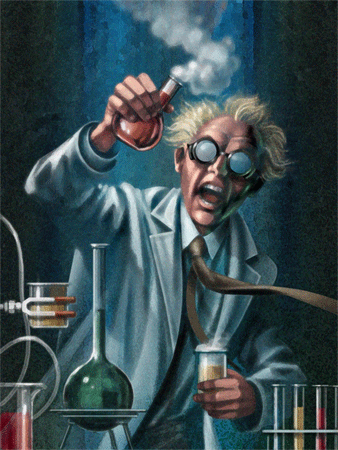How I Invented Turbulence Training for Fat Loss
 This is the story of how I discovered Turbulence Training for Fat Loss…it involved a scientific laboratory, dubious dietary supplements, radioactive isotopes, and mounds of medical research…
This is the story of how I discovered Turbulence Training for Fat Loss…it involved a scientific laboratory, dubious dietary supplements, radioactive isotopes, and mounds of medical research…
In fact, this wild adventure takes place in 1999 while I was still a lowly graduate student at McMaster University in Canada studying the effects of androstenedione on blood testosterone levels of healthy young men.
(You might remember Androstenedione as the supplement taken by the mighty Mark McGwire during his record-breaking home run quest in ’98).
It was a pretty cool little study, if you’re geeky enough to accept a science experiment as “cool”. It involved me sticking needles in people (one of my subjects fainted while I was drawing his blood) and guys doing hardcore Turbulence Training style workouts to exhaustion. 
Plus, the subjects had to take capsules of mysterious white powder. (One guy coughed after he swallowed his capsules, and white powder came out his nose. Good times!)
This research study ended up getting published in the Canadian Journal of Applied Physiology (for any science nerds out there keeping score).
The workouts consisted of mostly machine exercises (for standardization), and each subject did leg press, pulldowns, regular bench press, shoulder press, and machine biceps curls for 4 sets to failure. We gathered blood samples before and after for some hormone measurements.
Basically, the stuff doesn’t do “jack squat” for boosting testosterone, and all it does is increase estrogen, so Andro wouldn’t help McGwire increase anything other than his “mansierre” size.
 But that’s another story for another day…after we did the weight workouts, I was stuck in the lab analyzing the blood samples using some fancy radio-active isotopes.
But that’s another story for another day…after we did the weight workouts, I was stuck in the lab analyzing the blood samples using some fancy radio-active isotopes.
And when I say stuck in the lab, I mean STUCK. I’d get there at 7am, and record my last data point at 11pm. Sixteen hours of mad science.
Plus, at the same time, I was reading through dozens of medical research papers trying to connect exercise, hormones, and muscle building.
(By the way, in case you believe that the hormone boost from squats and deadlifts actually means anything, you are sorely mistaken…again, another article for another day.)
Alright, so now we have a pretty good recipe for a “restless” Craig. Combine 16 hours in a lab plus time in a library and no workouts, and I was starting to feel like a caged animal.
After all, before this, I was used to training all the time, and playing sports, lifting, and heck, just walking around, not being changed to research table. But there I was, studying for a degree in Exercise Physiology and left with no time for exercise.
Or so I thought.
There was one window of opportunity still open. Due to the set-up of blood analysis, I had a chance to have a 50 minute break, and I realized, based on
Fortunately, I actually had a 50 minute window once per day of “down-time” while the lab’s gamma-counter analyzed blood samples. So I found a way to get to the gym (5 minutes across campus) and do a short burst workout in the remaining 40 or so minutes.
With everything I had discovered from Exercise Physiology classes, over 5 years of bodybuilding, and from training athletes for over 2 years, I already knew how I could get maximum results in minimum time. (That’s right, my bodybuilding background played a big role in creating Turbulence Training).
I connected supersets, sprint intervals, and short rest periods and realized that was the way for maximum results. You’d build muscle, burn fat, and increase both your anaerobic and aerobic fitness with this program design. I knew it then, and research has proven it now.
For months I had been using intervals with athletes to help them get into mid-season shape before the season even started…and I noticed they were losing body fat at the same time. Plus, the supersets idea came from bodybuilding, as did the decision to stick to multi muscle movements. However, I knew that the high-volume bodybuilding approach had to go.
But in the past 3 years I had read hundreds of strength training studies and I knew exactly what exercises I needed to do to maximize my strength training time in the gym, including squats, presses, rows, power cleans, and plenty of other standing single-leg exercises.
And finally, I knew that intensity was the key. Later research would prove me right again, and would show that you’ll get more results with heavier weights, not sets of 15-20 easy repetitions.
So I had my plan.
Next time, I’ll share with you the first Turbulence Training workout done on a cold, dreary Canadian winter afternoon…
Who would have ever known what was going to happen next,
Craig Ballantyne, CSCS, MS